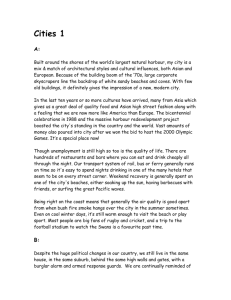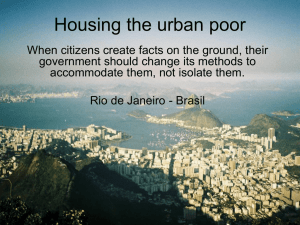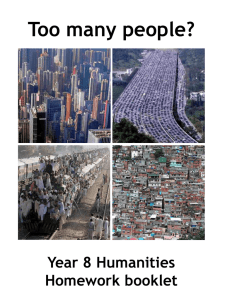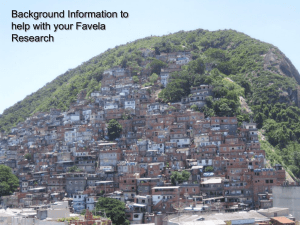Favelas - Stone Center for Latin American Studies
advertisement
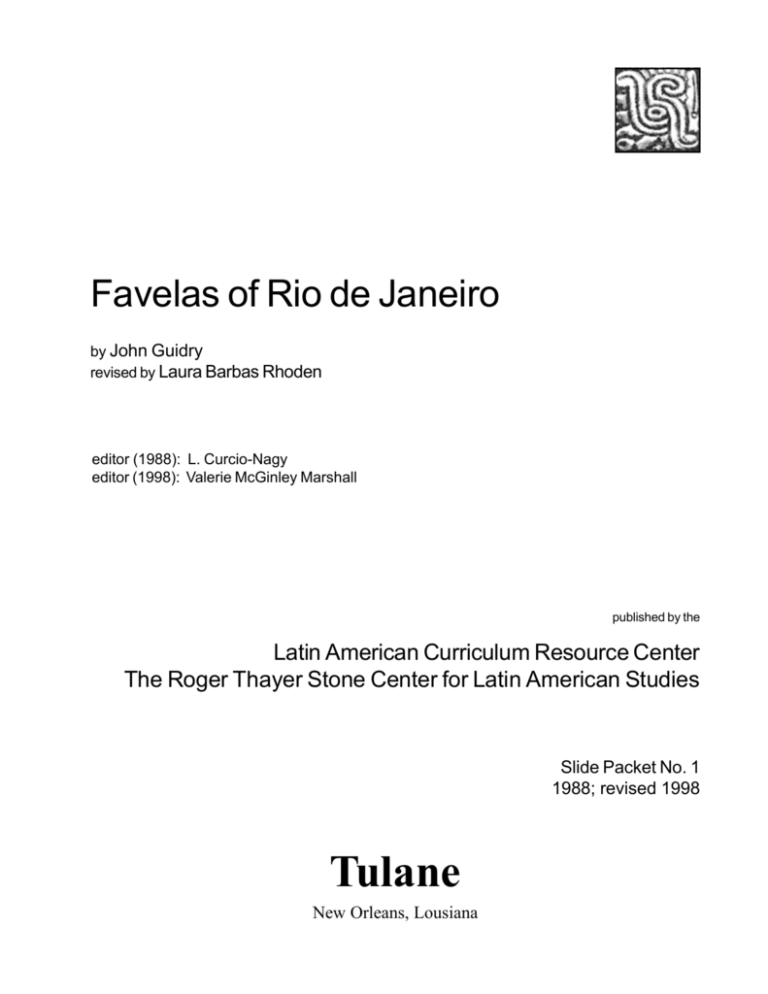
Favelas of Rio de Janeiro by John Guidry revised by Laura Barbas Rhoden editor (1988): L. Curcio-Nagy editor (1998): Valerie McGinley Marshall published by the Latin American Curriculum Resource Center The Roger Thayer Stone Center for Latin American Studies Slide Packet No. 1 1988; revised 1998 Tulane New Orleans, Lousiana Favelas of Rio de Janeiro F avelas are squatter settlements, and though the term is particularly used in Brazil, these settlements occur throughout Latin America. The squatter settlement is a common pattern of urban residence throughout the less-developed world. In many large cities, thousands of people of the lower socio-economic classes settle on land that is unoccupied, regardless of its legal ownership. In the large urban centers of Latin America, this undeveloped land is often located on steep hillsides or in swampy lowlands, areas with little potential for lucrative commercial or residential development. Frequently, lower income earners begin to build dwellings in these places, forming a favela. Another important factor in the growth of favelas is the legal tradition of Latin American countries. This legal tradition ensures greater protection for squatters than either the North American or northern European traditions, and this has contributed to the growth of these communities. tor, while the informal sector includes activities such as shoe-shining, street vending, and car washing. The informal economy operates outside the formal economy and is difficult to regulate; the urban poor most frequently engage in its activities. In the last two decades, the favela neighborhoods have gone through a great deal of change under various government programs. The following slide presentation highlights the efforts made to upgrade the urban services provided to the favela, including attempts to provide electricity, water, sewers, school, and medical programs. Such services were either scant or non-existent as recently as the mid-1980s. Though many people presume that the principal occupants of favelas are newly arrived migrants from rural areas, research has shown that this is not always true. Though a high percentage of newly arrived migrants seek out residence in squatter areas, the dominant pattern in favelas is one of long-term residence, unless the settlement is disrupted by government relocation programs. Favelas have then become an important housing option for the urban lower class, both migrant and long-term resident. In economic terms, favela residents are generally employed in the informal sector of the economy. Latin American countries are often described as having two parallel economies, a formal and an informal economy. Industries and services that provide formal wage employment comprise the formal secFAVELAS OF RIO DE JANEIRO 1 Slide Descriptions 1. COPACABANA BEACH. Rio de Janeiro is a large and beautiful city. The people, the beaches, and the mountains have produced a unique metropolis popular as a jet-set tourist mecca. This is the Rio de Janeiro known to most of the world. 2. TYPICAL STREET. Rio is a developed, industrial city. Brazil’s most important port, it is also an important center for government, research, education, and cultural activities. Tall buildings are not uncommon, and the street activity in some sectors is similar to that of European and North American cities. 3. TYPICAL STREET. Most of the world does not see the Rio de Janeiro that exists behind the tourist and business centers. Although Brazil has recently boasted the world’s eighthlargest economy (in terms of the growth of its GNP), it is far from identical to the economies of Western Europe and the United States. 4. LEBLON AND IPANEMA FROM VIDIGAL, A FAVELA. Behind the façade of economic growth is another world, one characterized by hunger, racial and economic discrimination, and a lack of social services. In the hills near some of Rio’s wealthiest neighborhoods, as well as in the northern industrial districts, there are huge squatter settlements known as favelas. The contrast between the rich and poor in Brazil, particularly in Rio, is quite visible. This photo presents a view of the posh Leblon and Ipanema districts of Rio, seen from the favela Vidigal. 5. NEIGHBORHOOD ADJACENT TO VIDIGAL FAVELA. Often the favelas and upper-class neighborhoods are adjacent to one another. This is the case with Vidigal, which shares a hillside with the middle and upper class apartments seen in this slide. About 12% of Rio’s 8 million inhabitants live in favelas. Though the name favela is usually applied only in southern Brazil, favelas may be found in and around any large Latin American city. 6. VIDIGAL FAVELA. Vidigal is located directly behind the Sheraton Hotel, next to other middle-class sections of the Vidigal district. It is also close to the upper class districts of São Conrado, Leblon, and Ipanema. This location is important for the low-income residents of the favela because the higher income neighborhoods provide a source of employment for many favelados. Over 50% of the female faveladas are employed as domestic servants in middle and upper class households. 7. GERALDO AND HIS HOUSE. The construction of the favelas is autonomous, that is, the favelados build their own houses. There are several stages of construction, and the favelados constantly work to improve their homes. In this photo, we see Geraldo, age 22. He built the house to the left in this slide; the home is in the first stage of construction. Geraldo’s building technique is one common in the rural areas of Brazil. First, the builder constructs a wood frame, part of which is exposed, and then fills in the holes with mud. Finally, he covers the outside of the house with plaster. The category name in the Brazilian census for this type of housing is simply “rustic.” FAVELAS OF RIO DE JANEIRO 3 8. STREET IN VIDIGAL. The second stage of construction is to rebuild the house in brick. Often the brick itself is left without plaster. Favela residents stockpile bricks and save them for expansions and improvements. The rebuilt home will be adjacent to or on the same site as the original dwelling. 9. STREET IN RECREIO DOS BANDEIRANTES. Although favelas seem from a distance to be large, unorganized slums, they are quite different from the inside. Once inside the favela, the visitor notes the hectic din of activity. Those who are not working at a job outside the favela continue construction on their homes. Some may also been found caring for domesticated animals, usually pigs and fowl, which provide an important food source. 10. VIDIGAL HILLSIDE. A resident’s lot in a favela is not very large, and once the limit of the lot is reached, there is nowhere to go but up. Building upwards is the third stage of favela construction. Often many rooms may be constructed before crowding is alleviated. Geraldo, the man we saw in the first stage of construction, has 12 people living in his oneroom house, and he hopes to rebuild with brick, with further expansion planned in the future. 11. FAVELA EXPANSION IN RIO DE JANEIRO. The expansion of favelas in Rio is not an organized phenomenon; it is gradual and haphazard. In Rio, these neighborhoods are not usually formed through “land invasions” as they are elsewhere in Latin America. They often grow from a few dwellings at the bottom of a hill or at the edge of an uninhabited area and soon cover whole hills in the city or marshy lands north of the older city. 12. JOÃO CARLOS AND HIS HOUSE. In this slide, 28-year-old João Carlos is standing on what will become a new addition to his house. João’s parents moved to Vidigal before he was born, and he has lived there all of his life. João lives with his two sisters, and an aunt and several cousins live next door. He hopes to gain some extra income by renting the new portion of his house. 13. INSIDE JOÃO CARLOS. Because affordable housing for the working and lower classes in Rio is scarce, João Carlos should be able to gain extra income by renting rooms. Inside, the house is clean and cozy, though not lavishly furnished. Many favela houses are furnished better than João Carlos’, and many are less so. 14. HALLWAY, JOÃO CARLOS’ HOUSE. The most important thing to remember about favelas is that they are communities that are created and sustained through the efforts of their residents. Favelas represent a practical solution to the chronic housing shortages that have characterized developing economies in Latin America. Favelados build their houses themselves with materials for which they have often saved for months or years. The communities that form in the favela are socially complex and have an important informal economy. 4 FAVELAS OF RIO DE JANEIRO 15. PEOPLE IN RECREIO DOS BANDEIRANTES. Community solidarity is one of the most important characteristics of favela life. Statistics show that family bonds are quite strong in favelas, where there are lower divorce rates and fewer single-parent homes than in other sectors of Brazilian society. Churches and other integrating organizations, such as soccer clubs, dance schools for Carnaval, and residents’ associations provide high levels of social cohesion in these neighborhoods. 16. PEOPLE IN RECREIO DOS BANDEIRANTES. Favelados do not have much money. Despite a misconception in Brazilian society that favelados do not work, the unemployment level of the favela is comparable to the average for the regions where favelas are located. However, the jobs offered to favelados are those at the lowest levels of industrial and manual labor. This is due both to low levels of work skills and discrimination against the favela dweller. 17. PEOPLE IN RECREIO DOS BANDEIRANTES. Unemployed family members are important resources for favela dwellers because they can continue construction work while the others are away. This is an important component in the informal economy of the favela. Numerous little stores, bars, and shops also contribute to the informal economy. Children may also work to supplement family income, though this is not preferred. Residents are aware of the value of education and share middle class expectations about the education of their children. 18. RESIDENTS’ ASSOCIATION MEETING, VIDIGAL. One sign of the value favelados place on solidarity is the Residents’ Association. Each favela has such an organization to represent the interests of the favela in the community at large. This slide shows a meeting of such a Residents’ Association. The woman in the pink shirt is discussing a health program provided by the residents’ association for the favelados. She explains the program to the people present, and they in turn disseminate the information throughout the community. 19. SICK MAN IN RECREIO DOS BANDEIRANTES. Health is a major concern for the Residents’ Association and for the government. The government has recently undertaken many programs in favelas; these are aimed at “urbanization,” that is, the integration of the favela into the social service and political infrastructure of the city. Among services the government has begun to provide in the favelas are “health posts” (postos de saude). The posts are maintained by the government with the cooperation of the residents’ association and care for minor health needs, emergencies, and vaccinations. 20. COMMUNITY CENTER AND CRECHE, VIDIGAL. This community center is a good example of the developing cooperation between the Residents’ Associations and the government. Using only the favelados’ resources, the Residents’ Association built this center in Vidigal. The building houses the creche, or pre-school. The education and food the children receive are part of a government program. FAVELAS OF RIO DE JANEIRO 5 21. ELECTRIFICATION, VIDIGAL. Elecrification is another government urbanization program. The electrification of the favelas has a long history filled with corruption and exploitation on all sides. The losers, however, were nearly always the favela residents. The current urbanization programs hope to increase the availability of energy to the favelas in an efficient and indiscriminatory manner. 22. WATER, VIDIGAL. These water tanks have become more common on tops of favela houses. This is also part of urbanization. As recently as 1985, favelados still had to trek steep hills in order to obtain their daily supply of water for drinking, cooking, and cleaning. 23. PAVING OF ROADS. The paving of roads is a recent addition to the urbanization program. Many favelas are located on steep hillsides, and roads and paths frequently washed out with the rains. Dangerous mudslides also often took residences with them. For favelas located in swampy flatlands, rains often produced intolerable floods and muddy bogs in what were once roads. 24. CATHOLIC MASS, RECREIO DOS BANDEIRANTES. The favela is linked to the urban society by more than just government programs and participation in the local economy. Religious groups have extensive operations in the favelas. In this slide, we see Catholic Mass in Recreio dos Bandeirantes. Although most favelados are nominally Catholic, the religious life in the favela is diverse and includes many Protestant denominations. 25. CATHOLIC MASS, RECREIO DOS BANDEIRANTES. There are large groups of Pentecostal and other evangelical churches operating in the favelas, and many of the residents attend the services of these missions. Also, extremely significant in the religious life of the favela and of all of Brazil are the macumba and candomblé variants of Catholic-African religious syncretism. Many Brazilians hold both Roman Catholic beliefs and beliefs in African religions brought to the Americas by slaves during the colonial period. Other variants of this type of religious fusion are voodoo and santería, practiced in the Caribbean and the United States. 26. PEOPLE IN RECREIO DOS BANDEIRANTES. Many members of Brazilian society have a prejudiced view of the favela. The middle and upper classes tend to view the favela as a home to the drug culture, criminals, and the unemployed. It is perceived as a place with little social cohesion and a lack of traditional values. The word Brazilians often employ to characterize favelados is malandro, or “good-for-nothing,” though a close look at the favela from within dispels many of these notions. 27. PEOPLE IN RECREIO DOS BANDEIRANTES. The favela is a low-income neighborhood struggling to survive. Favelados occupy an important place in the informal and formal sectors of the economy and provide an important example of autonomous improvement by people with few resources. 28. CHILD, RECREIO DOS BANDEIRANTES. The experience of the favela will figure prominently in Brazil’s future, since over 50% of the population is under 18 years of age. The challenge for Brazil and the favelados is to overcome both the prejudices and the economic disadvantages that reproduce poverty at an ever-increasing rate. 6 FAVELAS OF RIO DE JANEIRO Questions and Activities 1. How might the favelado participate in both the informal and formal sectors of the economy? How are the two economies interconnected? How does each impact the other? 2. In the United States, we take simple services such as electricity, running water, sewage systems, and public schooling for granted. Favelados are often without these services. How might life be different for the students in the class if they did not have these utilities and public services available? What might they do to get the government to provide these services? 3. Favelados endure many prejudices because of their racial or ethnic background and because of their low socio-economic status. Does there exist any similar pattern of discrimination in the United States? How is the situation in the United States either similar or different? 4. What is the function of favela groups such as soccer clubs, dance schools, residents’ associations, church groups, etc.? What benefits (social and otherwise) do these associations provide? Compare the situation of the favelados with that of the urban poor in the United States. Are there similar groups in lower income areas? How are their functions different or similar? FAVELAS OF RIO DE JANEIRO 7 Additional Readings Jesús, Carolina María de. Child of the Dark: The Diary of Carolina María de Jesús. Trans. David St. Clair. New York: Signet, 1962. Levine, Robert M. and José Carlos Sebe Bom Meihy. The Life and Death of Carolina María de Jesús. Albuquerque: UNM Press, 1995. Perlman, Janice. The Myth of Marginality: Urban Poverty and Politics in Rio de Janeiro. Berkeley, CA: UC Press, 1976. Pino, Julio César. Family and Favela: The Reproduction of Poverty in Rio de Janeiro. Westport, CT: Greenwood Press, 1997. Portes, Alejandro. “Housing Policy, Urban Poverty, and the State: The Favelas of Rio de Janeiro, 1972-1976.” Latin American Research Review 14.2 (1979): 3-14. Valladare, Licia. “Housing in Brazil: An Introduction to Recent Literature.” Latin American Research Review 2.2 (1983): 69-91. 8 FAVELAS OF RIO DE JANEIRO This packet is made possible through the generous funding of the Tinker Foundation, Inc. and the Roger Thayer Stone Center for Latin American Studies, Tulane University. © 1988, 1998 by the Roger Thayer Stone Center for Latin American Studies, Tulane University. Permission is granted for the reproduction of this packet for classroom use only.


